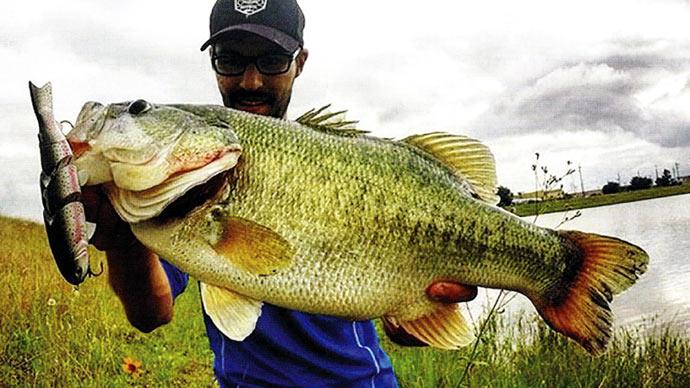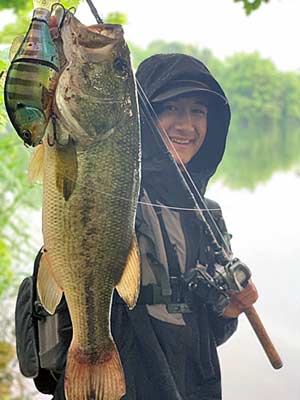
Are you intimidated by big swimbaits? You shouldn’t be -- big swimbaits are one of the best ways to catch big bass. The key to fishing these monster baits is the right equipment and techniques. Believe it or not, fishing from shore is a dynamite way to fish these big baits no matter where you live. To prove it, we interviewed two swimbait specialists – one from New York City and one from Arizona. Both of them fish big swimbaits regularly.
Big City Ponds
Alex Atack’s Instagram handle is @Japanesebassman, and all of his posts are photos of big bass caught in ponds in and around New York City, all caught from shore. Yup, New York City. One of the benefits of fishing a pond, says Alex, is that it doesn’t take long to cover the whole thing. He often starts walking the entire bank with a square bill crank to eliminate water. He focuses on points because of the bass, like access to deep water.
Fishing from shore gives you an advantage, Alex says because you are moving uphill so you can keep in contact with the bottom for your entire retrieve. During the summer, fishing from shore means easy access to mats, grass, and other cover. One drawback of fishing the ponds in and around New York City is lots of pressure: you may find twenty fishermen in just 50 yards of the bank. This is one of the significant reasons why Alex switched to big swimbaits.
“My favorite baits are 6- to 8-inch glide baits,” Alex says, “and I want perfection in the lure. If it looks like the baitfish in the pond you’re fishing, you’ll get a lot of bites.” He has a friend who makes and paints custom swimbaits for him, but he also fishes a lot of 68 Huddleston baits, especially if there are a lot of snags he wants to avoid. The Huddleston is weedless, with minimal hook exposure.
Alex keeps his gear minimal, putting everything he needs in a single backpack. “Once you’ve figured it out, you don’t need to carry around a ton of tackle,” he says, “a water bottle and my best five or six confidence baits is about all I need.” He also keeps a few jigs and a small bag of plastics for every two jigs. His rod is a Dobyns’ 806 Champion Swimbait rod, paired with a Daiwa Ryoga 1016 reel, spooled up with 20-pound-test fluorocarbon line. He uses a split ring on all his crankbaits and a snap-on hard glide baits and ties on with a 5-wrap Uni knot. If he’s using a leader, he attaches it to the main line with an improved Albright knot.
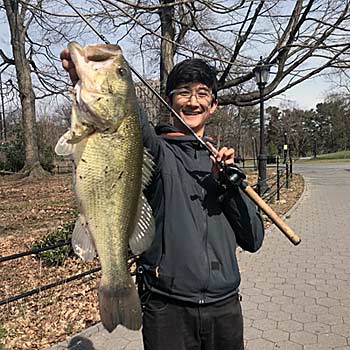
Alex’s Technique
This time of year, he starts with a big bait right away. He usually fishes a topwater in warmer weather, but he goes straight to the big guns when it’s cold out. He casts it out as far as he can and lets it sink to the bottom in winter. Once the big bait is on the bottom, he waits five to ten seconds to let any spooked fish calm down and come back, then begins a steady retrieve. “I let the nose bounce, bounce, bounce,” he says, “there’s never really a hard bottom in the ponds I fish, but there are branches, grass, and things like that. When the bait bumps something, that’s when you’ll get bit.”
As for the bite, Alex says to imagine the nose of the bait getting stuck, then popping down – that’s when you’ll feel it. The bite is a tick as the bass sucks the whole bait in. You’ll miss smaller fish, but you’ll be amazed how big a bait a two-pound bass can eat. Fish on the highly pressured ponds he fishes have seen everything hundreds of times, he says, and since it is all catch and release, they keep getting smarter and wiser. That’s why he wants his baits to look realistic. Bluegills are harder for bass to eat, so he doesn’t generally use bluegill replicas. He prefers longer, narrower baits. Sometimes the walk around the pond is just ten minutes, but things can still change. When that happens, he starts over with a crankbait in the open, trying to find them.
“In winter, when the water is cold, everyone slows down, but I speed up. It gets them to commit,” he says. Also, the deeper water is warmer in the winter, so he’ll pick a point where all the fish have to go around and fish there. It’s an ambush point, and big bass will sit there and wait for the smaller fish to swim past. He uses Google Maps and Navionics to find good points and structure. You can download the Navionics app; a year’s subscription is $14.99.
Manny Chee – Western Reservoirs From Shore
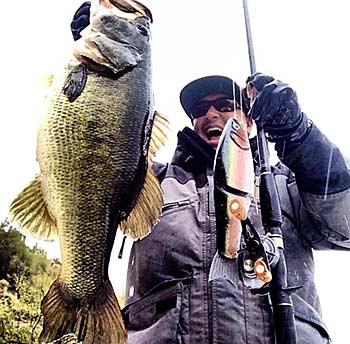
Manny Chee is an Arizona fishing guide who specializes in swimbaits. Twelve years ago, he watched big bass chasing down the trout that the Game and Fish Department was stocking in one of Arizona’s reservoirs, and they were huge bass. He decided he needed to target those big bass, so he started by following #swimbaits on Instagram and then just started fishing them. Now he chases trophy bass with swimbaits and teaches people how to use them. “This isn’t a tournament fisherman’s technique,” he says, “you’re probably not going to get a limit with a big swimbait, but you’ll catch quality fish.”
He almost exclusively fished Deps Slide Swimmer 250’s for the first four years. He loves this bait because you can walk the dog underwater with it just by reeling. These baits hover their way down into deeper water – they’re tuned to sink at a specific rate, and they make an S- or Z-shaped pattern when you reel them just under the water, and all the action is imparted by how you reel.
Manny says many big fish hang out in shallow water, and a swimbait is a fantastic technique to get them to bite. “People think fish are slow, and I watched videos of people fishing swimbaits super slow, but I think this is a standard error. In reality, fish follow a slow bait but often don’t react. Maybe they follow it for a bit and nip at it, but that’s it. I’d get 20 to 30 followers daily fishing slow, watching what would be a personal best follow the bait without committing. He says people stop the bait when this happens, but that’s the exact opposite of what a natural baitfish would do. It would run. So he used his hunter’s instinct, took that S-pattern, and turned it into a tight Z with more flash and action while still keeping it in the strike zone. He says there’s minimal rod tip action – it’s all done with the reel. He fishes swimbaits like a reaction bait, like something trying to get away, but maybe it’s wounded. That’s what makes the bass commit.
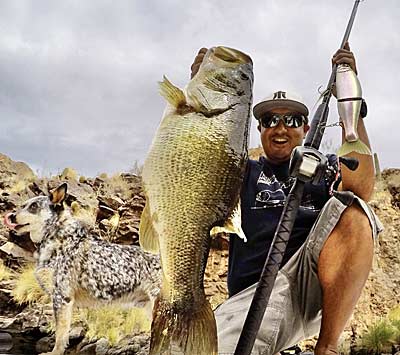
You have the right equipment to get a good hookset on a big swimbait. He uses a big swimbait rod with a progressive taper. As for the reel, Manny recommends a 6:1, 300-size low-profile reel for beginners. Once you get good, a Deps reel in 7:1 is ideal. You need stretch in line with treble hook baits, so he uses 20- to 25-pound test mono or copolymer. The hookset is a downward sweep like a jerkbait or a crankbait, keeping the pressure on and the rod in the water. He also carries an enormous net, so big that people often laugh at it until they see how he sweeps the big bass into it. “I catch a lot of 10+ fish, so a big net is a must,” he says.
The best time of year for swimbaits in warmer states is October through May. “Any time that’s not summer,” he says. He usually catches his biggest fish in mid to late February, prespawn. He says those prespawn fish are best fished deep to shallow, so shore fishing is ideal. Guys in boats should get right up next to shore and cast out to deeper water. Throw it as far as you can, beyond the structure, then let it sink to the bottom and skip it back – the best spots are rocky, chunky parts, and the best fish take the best spots. Manny says that you must use mapping software and electronics if you're fishing from shore. You’ll want to hit each place a few times, then move on. Find a few places with the Navionics app and revisit them as a milk run.

Big bass often eat the bait right where it’s pinned to shallow water, he says – they have to eat it now or lose it. Big bass want big food, but they want to ambush it, not chase it for the most part.
Like Alex, Manny also likes the Huddleston baits and fishes the Working Class Zero Battles Shad. These single-hook baits can be skipped and pitched under docks.
With these baits, you need a stiffer rod and fluorocarbon line. When they bite, reel down and hit them hard, then quickly get the rod back into the water. He says that if you’re fishing it really shallow, treat it like a frog. When you get hit, count 1-1000, 2-1000, 3-1000 before your hookset, or you’ll pull it away from him. Keep the line taut so you can feel the tics in the reel through the line, and don’t pop the rod. Just reel up the line, and they’ll hang onto it. Once you can’t reel anymore, set the hook.
Fishing swimbaits has taught Manny a lot about bass behavior, and on his guide trips, he tries to teach his clients what he has learned. He also has a new YouTube channel, and you can see his Instagram videos and photos by following @MannyChee. He has a website as well. Manny loves to share his swimbait know-how, so check it out.
BassResource may receive a portion of revenues if you make a purchase using a link above.




